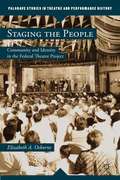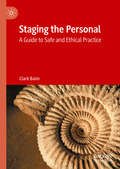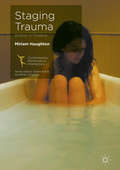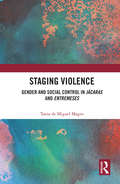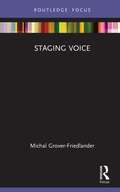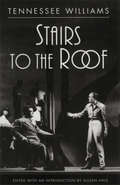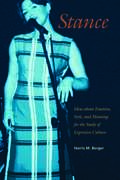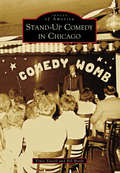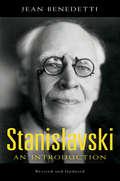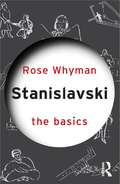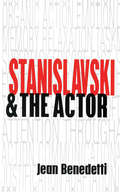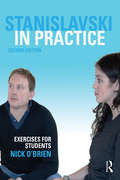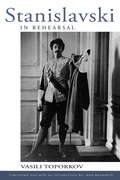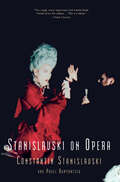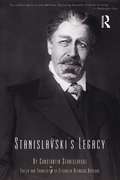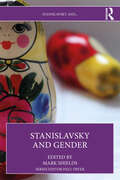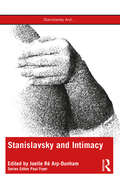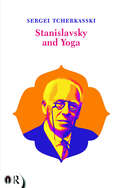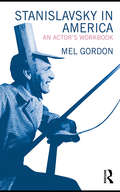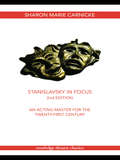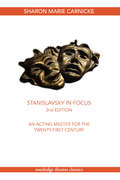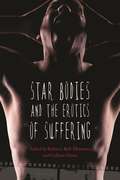- Table View
- List View
Staging the People
by Elizabeth A. OsborneThe Federal Theatre Project stands alone as the only national theatre in the history of the United States. This study re-imagines this vital moment in American history, considering the Federal Theatre Project on its own terms - as a "federation of theatres" designed to stimulate new audiences and create locally-relevant theatre during the turbulent 1930s. It integrates a wealth of previously undiscovered archival materials with cultural history, delving into regional activities in Chicago, Boston, Portland, Atlanta, and Birmingham, as well as tours of refugee camps and Civilian Conservation Corps Divisions. For a brief, exhilarating moment, the Federal Theatre Project created a democratic theatre that staged the American people.
Staging the Personal: A Guide to Safe and Ethical Practice
by Clark BaimThis book examines the history, ethics, and intentions of staging personal stories and offers theatre makers detailed guidance and a practical model to support safe, ethical practice. Contemporary theatre has crossed boldly into therapeutic terrain and is now the site of radical self-exposure. Performances that would once have seemed shockingly personal and exposing have become commonplace, as people reveal their personal stories to audiences with ever-increasing candor. This has prompted the need for a robust and pragmatic framework for safe, ethical practice in mainstream and applied theatre. In order to promote a wider range of ethical risk-taking where practitioners negotiate blurred boundaries in safe and artistically creative ways, this book draws on relevant theory and practice from theatre and performance studies, psychodrama and attachment narrative therapy and provides detailed guidance supporting best practice in the theatre of personal stories. The guidance is structured within a four-part framework focused on history, ethics, praxis, and intentions. This includes a newly developed model for safe practice, called the Drama Spiral.The book is for theatre makers in mainstream and applied theatre, educators, students, researchers, drama therapists, psychodramatists, autobiographical performers, and the people who support them.
Staging Trauma: Bodies In Shadow (Contemporary Performance Interactions )
by Miriam HaughtonThis book investigates contemporary British and Irish performances that stage traumatic narratives, histories, acts and encounters. It includes a range of case studies that consider the performative, cultural and political contexts for the staging and reception of sexual violence, terminal illness, environmental damage, institutionalisation and asylum. In particular, it focuses on 'bodies in shadow' in twenty-first century performance: those who are largely written out of or marginalised in dominant twentieth-century patriarchal canons of theatre and history. This volume speaks to students, scholars and artists working within contemporary theatre and performance, Irish and British studies, memory and trauma studies, feminisms, performance studies, affect and reception studies, as well as the medical humanities.
Staging Violence: Gender and Social Control in Jácaras and Entremeses
by Tania de Miguel MagroStaging Violence explores gender violence in Spanish early modern short theater. This book deals with domestic violence against women, extortion of prostitutes, and violence against men who display non-conventional forms of masculinity. The author argues that many "jácaras" and "entremeses" stage subversive discourses that repudiate or complicate official narratives of gender and the use of violence as a tool for achieving gender compliance. Short comic pieces are read against comedias. Each section of the book is expertly contextualized through an overview of the legal and moral contexts and the analysis of a variety of primary sources (law codes, manuals of conduct, church rulings, transcripts of civil and religious trials, and medical manuals) as well as statistical information. Staging Violence invites the reader to consider the transgressive potential of performance. As the first monograph entirely dedicated to the study of gender in this genre, this book is a vital resource for students and scholars interested in gender studies and theatre.
Staging Voice (Routledge Voice Studies)
by Michal Grover-FriedlanderStaging Voice is a unique approach to the aesthetics of voice and its staging in performance. This study reflects on what it would mean to take opera’s decisive attribute—voice—as the foundation of its staged performance. The book thinks of staging through the medium of voice. It is a nuances exploration, which brings together scholarly and directorial interpretations, and engages in detail with less frequently performed works of major and influential 20th-century artists—Erik Satie, Bertolt Brecht and Kurt Weill—as well as exposes readers to an innovative experimental work of Evelyn Ficarra and Valerie Whittington. The study is intertwined throughout with the author’s staging of the works accessible online. This book will be of great interest to students and scholars in voice studies, opera, music theatre, musicology, directing, performance studies, practice-based research, theatre, visual art, stage design, and cultural studies.
Stairs to the Roof
by Tennessee Williams Allean HaleA play produced only twice in the 1940s and now published for the first time reveals that Tennessee Williams anticipated the themes of Star Trek by decades. Sixty years ago a young Tennessee Williams wrote a play looking toward the year 2001. Stairs to the Roof is a rare and different Williams' work: a love story, a comedy, an experiment in meta-theater, with a touch of early science fiction. Tennessee Williams called Stairs to the Roof "a prayer for the wild of heart who are kept in cages" and dedicated it to "all the little wage earners of the world." It reflects the would-be poet's "season in hell" during the Depression when he had to quit college to type orders eight hours a day at the International Shoe Factory in St. Louis. Stairs is Williams' revenge, expressed through his alter ego, Benjamin Murphy, the clerk who stages a one-man rebellion against the clock, the monotony of his eight-to-five job, and all the dehumanizing forces of an increasingly mechanized and commercial society. Ben's swift-moving series of fantastic adventures culminate in an escape from the ordinary that is an endorsement of the American dream. In 1941 with the world at war and civilization in danger of collapse, Williams dared to imagine a utopian future as Ben leads us up his stairs towards the Millennium. Stairs to the Roof was produced only twice, once at the Playbox in Pasadena, California, in 1945, and subsequently at the Pasadena Playhouse in 1947. Now, in an edition meticulously prepared by noted Williams scholar Allean Hale, Williams fans can share this play of youthful optimism.
Stance: Ideas about Emotion, Style, and Meaning for the Study of Expressive Culture (Music Culture)
by Harris M. BergerWhy does music move us? How do the immediate situation and larger social contexts influence the meanings that people find in stories, rituals, or films? How do people engage with the images and sounds of a performance to make them come alive in sensuous, lived experience? Exploring these questions, Stance presents a major new theory of emotion, style, and meaning for the study of expressive culture. In clear language, the book reveals dimensions of lived experience that everyone is aware of but that scholars rarely account for.Though music is at the heart of the book, its arguments are illustrated with a wide range of clear examples--from the heavy metal concert to the recital hall, from festivals to dance, stand-up comedy, the movies, and beyond. Helping ethnographers get closer to the experiences of the people with whom they work, this book will be of immediate interest to anyone in ethnomusicology, folklore, popular music studies, anthropology, or performance studies.
Stand-Up Comedy in Chicago
by Vince Vieceli Bill BradyTen years after Chicago saw its first full-time comedy club open, the landscape was decidedly different. "Stand-up comedy has exploded in the last couple of years," a club owner told the Chicago Tribune in 1985, "that's the only way to describe it: exploded." It was truly a comedy boom, with as many as 16 clubs operating at once, and it lasted nearly a decade before fading, taking with it some of Chicago's oldest comedy stages, including the Comedy Cottage, Comedy Womb, and Who's on First. Still, stalwarts like Barrel of Laughs (south) and Zanies (north) persevered. That part of the story is known; overlooked is the fact there was a comedy boom, period. To hear the story, it is as if stand-up comedy innately morphed from a dated nightclub scene to what one Chicago Sun-Times writer called "Chicago's atomic comedy blast."
Stanislavski: An Introduction, Revised and Updated (Performance Bks.)
by Jean BenedettiJean Benedetti's Stanislavski is the clearest and most succinct explanation of Stanislavski's writings and ideas, especially those in the Stanislavski's acting trilogy – An Actor Prepares, Building a Character, and Creating a Role – a staple of every actor's library. Now available in an attractive new edition, Stanislavski: An Introduction provides the perfect guide through the Master's writing.
Stanislavski: The Basics (The Basics)
by Rose WhymanStanislavski: The Basics is an engaging introduction to the life, thought and impact of Konstantin Stanislavski. Regarded by many as a great innovator of twentieth century theatre, this book examines Stanislavski's: life and the context of his writings major works in English translation ideas in practical contexts impact on modern theatre With further reading throughout, a glossary of terms and a comprehensive chronology, this text makes the ideas and theories of Stanislavski available to an undergraduate audience.
Stanislavski and the Actor: The Method of Physical Action (Performance Bks.)
by Jean BenedettiFirst published in 1999. Routledge is an imprint of Taylor & Francis, an informa company.
Stanislavski in Practice: Exercises for Students
by Nick O'BrienStanislavski in Practice is an unparalleled step-by-step guide to Stanislavski’s system. Author Nick O’Brien makes this cornerstone of acting accessible to teachers and students alike through the use of practical exercises that allow students to develop their skills. This second edition offers more exercises for the actor, and also new sections on directing and devising productions. Each element of the system is covered practically through studio exercises and jargon-free discussion. Exercises are designed to support syllabi from Edexcel, Eduqas, OCR and AQA to the practice-based requirements of BTEC and IB Theatre. This is the perfect exercise book for students and a lesson planner for teachers at post-16 and first year undergraduate level. New to this edition: Thoroughly reorganized sections, including 'Work on the Actor', 'Work on a Role' and 'Developing your Practice'; A new chapter on using Stanislavski when devising with a series of exercises that will allow students to structure and create characters within the devising process; A new chapter, Directing Exercise Programme, which will be a series of exercises that allows the student to develop their skills as a director; New glossary with US and UK terms; New exercises developed since the publication of the first edition; A new chapter going beyond Stanislavski, exploring exercises from Michael Chekhov, Maria Knebel and Katie Mitchell.
Stanislavski in Rehearsal
by Vasily Osipovich ToporkovVasili Toporkov was one of the rare outsiders ever to be invited to join the Moscow Art Theatre. Although already an experienced and accomplished artist, he was forced to retrain as an actor under Stanislavski's rigorous guidance. This is Toporkov's account of this learning process, offering an insight into Stanislavski's legendary "system" and his method of rehearsal that became known as the method of physical action. Spanning ten years - from 1928 to 1938 - Toporkov charts the last crucial years of Stanislavski's work as a director. Toporkov reveals Stanislavski as a multi-faceted personality - funny, furious, kind, ruthless, encouraging, exacting - waging war against clichés and quick answers, inspiring his actors and driving to despair in his pursuit of artistic perfection. Jean Benedetti's new translation of Toporkov's invaluable record restores to us the vitality and insight of Stanislavski's mature thoughts on acting.
Stanislavski On Opera
by Constantin Stanislavski Pavel RumyantsevBest known for his fundamental work on acting, Stanislavski was deeply drawn to the challenges of opera. His brilliant chapters here on Russian classics--Boris Gudonov and The Queen of Spades among them--as well as La Boheme will amaze and delight lovers of opera. Also includes 12 musical examples.
Stanislavski's Legacy: A Collection Of Comments On A Variety Of Aspects Of An Actor's Art And Life
by Constantin StanislavskiFirst Published in 1987. Routledge is an imprint of Taylor & Francis, an informa company.
Stanislavsky and Gender (Stanislavsky And...)
by Mark ShieldsStanislavsky and Gender explores the intimate and complicated relationship between the enduring influence of Konstantin Stanislavsky and the evolving phenomenon of gender. This book provides new insights through historical research, unpublished and newly translated materials, and contemporary perspectives from diverse scholars and practitioners.Readers will gain a nuanced understanding of how gender informs and intersects with the legacy of Konstantin Stanislavsky and its related traditions from historical, feminist, pedagogical, intersectional, and queer contexts. Stanislavsky and Gender combines historical and contemporary perspectives from scholars and practitioners from the UK, Ireland, the US, Australia, Russia, and Brazil. Their contributions cover theatre histories, her-stories, emotion, feminism, pedagogy, intersectionality, race, and queerness. Following each chapter, contributors are joined in conversation to discuss their writing in a broader context.Part of the "Stanislavsky And…" series, Stanislavsky and Gender will be invaluable to scholars, teachers, students, and practitioners interested in integrating perspectives on gender into their research, teaching, and practice of Stanislavsky's legacy and associated traditions, and theatre history, acting, directing, actor training, and pedagogy more broadly.
Stanislavsky and Intimacy (Stanislavsky And...)
by Arp-Dunham, Joelle RéStanislavsky and Intimacy is the first academic edited book with a focus on how intimacy protocols, choreography, and theories intersect with the broad practices of Konstantin Stanislavsky’s ‘system’. As the basis for most Western theatre and film acting, Stanislavsky’s system centers on truthful performances. Intimacy direction and choreography insists on not only a culture of consent, but also specific, repeatable choreography for all staged intimate moments. These two practices have often been placed as diametric opposites, but this book seeks to dispel this argument. Each chapter discusses specific Stanislavskian principles and practices as they relate to staged sexually intimate moments, also opening the conversation to the broader themes and practices of other kinds of intimacy within the acting field. Stanislavsky And... is a series of multi-perspectival collections that bring the enduring legacy of Stanislavskian actor training into the spotlight of contemporary performance culture, making them ideal for students, teachers, and scholars of acting, actor training, and directing.
Stanislavsky and Pedagogy (Stanislavsky And...)
by Stefan AquilinaStanislavsky and Pedagogy explores current thinking around the pedagogical implications of Stanislavsky’s work. The volume depicts the voices of a number of practitioners, teachers, and scholars who are themselves journeying with Stanislavsky, and who in his work find a potent instigator for their own pedagogical practice and study. This book outlines instances in which updated interpretations of Stanislavsky’s pedagogy are adapted to cater for contemporary needs and scenarios. These include the theatre industry, new digital technologies, the need to develop playfulness, application to a broad repertoire, performance as pedagogy, university managerialism, and interdisciplinary crossovers with dance and opera. The pedagogies that emerge from these case-studies are marked by fluidity and non-fixity and help to underscore the malleability of Stanislavsky’s system. Stanislavsky And... is a series of multi-perspectival collections that bring the enduring legacy of Stanislavskian actor training into the spotlight of contemporary performance culture, making them ideal for students, teachers, and scholars of acting, actor training, and directing.
Stanislavsky and Race: Questioning the “System” in the 21st Century (Stanislavsky And...)
by Siiri Scott Paul SkeltonStanislavsky and Race is the first book to explore the role that Konstantin Stanislavsky’s “system” and its legacies can play in building, troubling and illuminating today’s anti-racist theatre practices. This collection of essays from leading figures in the field of actor training stands not only as a resource for a new area of academic enquiry, but also for students, actors, directors, teachers and academics who are engaged in making inclusive contemporary theatre. In seeking to dismantle the dogma that surrounds much actor training and replace it with a culturally competent approach that will benefit our entire community, the “system” is approached from a range of perspectives featuring the research, reflections and provocations of 20 different international artists interrogating Stanislavsky’s approach through the lens of race, place and identity. Stanislavsky and … is a series of multi-perspectival collections that bring the enduring legacy of Stanislavskian actor training into the spotlight of contemporary performance culture, making them ideal for students, teachers and scholars of acting, actor training and directing.
Stanislavsky and Yoga (Routledge Icarus)
by Sergei TcherkasskiThis book deals with one of the most important sources of the Stanislavsky System - Yoga, its practice and philosophy. Sergei Tcherkasski carefully collects records on Yoga in Stanislavsky's writings from different periods and discusses hidden references which are not explained by Stanislavsky himself due to the censorship in his day. Vivid examples of Yoga based training from the rehearsal practice of the Moscow Art Theatre and many of Stanislavsky's studios (the First Studio in 1910s, the Second Studio and Opera Studio of the Bolshoi Theatre in 1920s, Opera-Dramatic Studio in 1930s) are provided. The focus of Tcherkasski's research consists of a comparative reading of the Stanislavsky System and Yogi Ramacharaka's books, which were a main source for Stanislavsky. Accordingly, Tcherkasski analyzes elements of the System based on Yoga principles. Among them are: relaxation of muscles (muscular release), communication and prana, emission of rays and reception of rays, beaming of aura, sending of prana, attention, visualizations (mental images). Special attention is paid to the idea of the superconscious in Yoga, and in Ramacharaka's and Stanislavsky's theories. Tcherkasski's wide-ranging analysis has resulted in new and intriguing discoveries about the Russian master. Furthermore, he reveals the extent to which Stanislavsky anticipated modern discoveries in neurobiology and cognitive science. In this book Tcherkasski acts as a researcher, historian, theatre director, and experienced acting teacher. He argues that some forty per cent of basic exercises in any Stanislavsky based actor training program of today are rooted in Yoga. Actors, teachers, and students will find it interesting to discover that they are following in the footsteps of Yoga in their everyday Stanislavsky based training and rehearsals.
Stanislavsky in America: An Actor's Workbook
by Mel GordonStanislavsky in America explores the extraordinary legacy that Constantin Stanislavski’s system of actor-training has left on acting in the US. Mel Gordon outlines the journey of Stanislavski’s theories through twentieth century American history, from the early US tours of the Moscow Art Theatre to the ongoing impact of 'The System' on modern American acting. This fascinating study by a leading theatre critic and practitioner provides hundreds of original acting exercises, used by the pivotal US figures who developed his teachings, such as Lee Strasberg, Stella Adler and Bobby Lewis. By going back to these primary sources, Gordon cuts through the myths and misapprehensions which have built up over time. Part memoir and part practical guide, Stanislavsky in America is an essential resource for anyone wanting to understand Stanislavski’s work and his relationship with American theatre.
Stanislavsky in Focus: An Acting Master for the Twenty-First Century
by Sharon Marie CarnickeFirst published in 1998. Routledge is an imprint of Taylor & Francis, an informa company.
Stanislavsky in Focus: An Acting Master for the Twenty-First Century
by Sharon Marie CarnickeStanislavsky in Focus brilliantly examines the history and actual premises of Stanislavsky’s 'System', separating myth from fact with forensic skill. The first edition of this now classic study showed conclusively how the 'System' was gradually transformed into the Method, popularised in the 1950s by Lee Strasberg and the Actor’s Studio. It looked at the gap between the original Russian texts and what most English-speaking practitioners still imagine to be Stanislavsky’s ideas. This thoroughly revised new edition also delves even deeper into: the mythical depiction of Stanislavsky as a tyrannical director and teacher yoga, the mind-body-spirit continuum and its role in the ‘System’ how Stanislavsky used subtexts to hide many of his ideas from Soviet censors. The text has been updated to address all of the relevant scholarship, particularly in Russia, since the first edition was published. It also features an expanded glossary on the System's terminology and its historical exercises, as well as more on the political context of Stanislavsky's work, its links with cognitive science, and the System's relation to contemporary developments in actor-training. It will be a vital part of every practitioner's and historian's library.
Stanislavsky’s Use of Improvisation
by Stefan AquilinaStanislavsky&’s Use of Improvisation is the first work that brings together material across Stanislavsky&’s entire career to survey his use of improvisation. Improvisation was a key concern for Stanislavsky, one that impinged on his acting, directing, and pedagogical work. Consequently, it features in many books on the System, but this study is unique because it focuses explicitly on improvisation and its place in Stanislavsky&’s development as a theatre-maker. This allows the reader to see how Stanislavsky treated improvisation as a highly mutable practice that was not bound to one particular interpretation, definition, or application. Improvisation will always relate to the present moment in an actor&’s work, to the here and now; it values aliveness and an engagement with the role. Beyond that, however, Stanislavsky&’s use of improvisation was a dynamic and expanded one that answered a range of work challenges.
Star Bodies and the Erotics of Suffering (Contemporary Approaches to Film and Media Series)
by And Colleen Glenn Rebecca Bell-MetereauSuffering in cinema can be crucial to how stars are cast in roles and perceived by audiences, whether it is performed on the screen or weathered in the form of scandal, heartbreak, disfiguration, or aging in an actor's real life. In Star Bodies and the Erotics of Suffering, editors Rebecca Bell-Metereau and Colleen Glenn assemble thirteen scholars to consider fourteen stars whose careers have been defined by suffering on- or off-screen. Together, these essays question assumptions that an actor's ability to project an enduring image--both symbolic and physical--is necessary for box-office success, demonstrating instead that disruptions often shape and direct the star image. Contributors in this collection examine a wide range of stars from the last seventy years. Some essays deal with actors who have transformed temporarily for a role, or permanently, through aging or accident, such as Joaquin Phoenix, Daniel Day-Lewis, Mickey Rourke, Charlize Theron, and Hilary Swank. Other essays consider stars' attempts to conceal aspects of themselves from the public in order to maintain a palatable public image, including Rita Hayworth, Rock Hudson, and Michael Jackson. Some explore typecasting and audience expectations, noting how struggles with marriage, divorce, and aging intersect in the images of Natalie Wood, Marilyn Monroe, and Harrison Ford. A final set considers Sissy Spacek, Julia Roberts, and Halle Berry as women who reconfigure negative press and restrictive gender and racial expectations to their advantage, managing public perceptions of suffering in ways that flummox their critics. Star Bodies and the Erotics of Suffering offers film buffs, students, and scholars a fresh take on casting, method acting, audience reception, and the tensions at play in our fascination with an actor's dual role as private individual and cultural icon.
